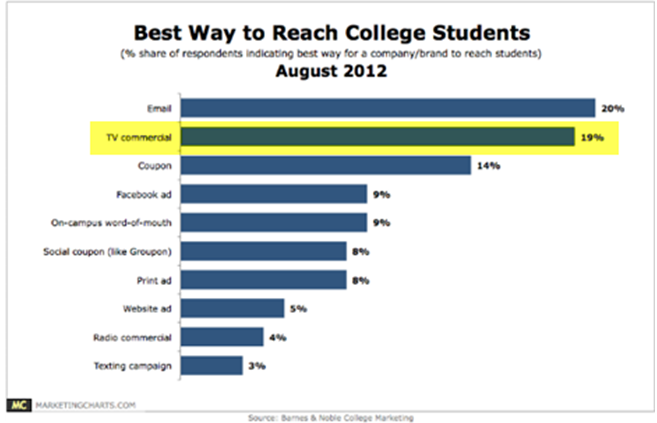
TV advertising for colleges has a long-standing tradition in higher education marketing. Higher ed ads have evolved a lot over the years from being more branding-oriented to the more lead generation, direct response type we see today.
The high-end branding campaign commercial is still in vogue, as seen in this example from the University of Michigan, which won a 2013 gold medal from EduAdAwards.
Branding ads typically target individuals at the top of the recruitment funnel, using inspirational and promotional content to invoke a strong positive impression of the institution.

These ads typically emphasize career and job prospects, playing a critical lead generation role in their institution’s marketing efforts. The example below, from Apollo-owned Carrington College, also won a gold medal in the 2013 EduAdAwards and nicely addresses branding and direct response objectives.

While the $200,000 ad agency-created TV ads are still being made, freelance production costs have dramatically reduced budgets for solid commercial work to as low as $25-50,000.
The rise of content marketing, as in video content, has also expanded the range of work produced by institutions internally, from student video blogging to high-end in-house video production of promotional, campus sports, and other events.
So, How Does the Traditional TV Spot Fit into Today’s Recruitment Practices and Norms?
Let’s start with an overview of all advertising dollars spent.
The chart below from the now-retired Educational Marketing Group website summarizes higher education marketing dollars spent in 2013 in the US.
Unfortunately, PPC marketing is not included in these stats, which skews things a bit. Even when factored in, TV advertising remains a very popular strategy.
In this analysis, TV and Cable TV advertising make up 42% of total spending. Marketers support TV advertising as a preferred tactic to reach their marketing goals.
 Source: Educational Marketing Group
Source: Educational Marketing GroupWhat Are Students’ Perceptions of TV Ads as a Channel to Reach Them?
In 2012, a Barnes and Noble College Marketing Group survey of students reported that their research indicated that TV commercials were a very effective means of reaching college students.
Barnes and Noble’s marketing differs from your school’s recruitment marketing but is a close cousin with the same target audience, giving us some insight.
 Source: Barnes and Noble College Marketing Group
Source: Barnes and Noble College Marketing Group
However, we need to be careful with these assumptions, as TV’s effectiveness will change as you break down your audience into more discreet segments.
The table below shows that these surveyed Masters level students see local TV advertising as the least effective marketing tactics and strategies.
Interestingly, 43% of the institutions surveyed in the category responded that they were running TV ads. This is a big disconnect, so if you are a master-level program marketer, you might want to examine the effectiveness of your ads more closely.

Source: Noel Levitz
I suspect career college students would respond quite differently if asked the same questions, but I don’t have that conclusion backed up with any specific data.
How Is TV Advertising Regarded for General Effectiveness by Higher Ed Marketers?
In 2013, Noel Levitz surveyed and reported on the importance of TV advertising in higher ed marketing.
At that time, private and public 4-year institutions ranked television ads as 37th of 53 tactics in their usage and effectiveness. Two-year public institutions ranked them much higher at 9th of 50.
This implies that TV is more effective for very targeted marketing in local catchment areas by more locally focused 2-year colleges. Given the typical targeting and reach of TV ads, this makes sense to me.
Unfortunately, in their 2014 follow-up report, Noel Levitz focuses more on E-recruitment. The efficacy of TV advertising was not included in their survey report, so we can’t compare it.
TV Advertising Can Be Done Effectively in Several Ways:
Tracking of offline marketing activity like TV Advertising Can Be Done Effectively, in Several Ways, using analytics. Approaches include:
– Setting up a vanity URL specifically for your TV ad campaign, publishing it prominently within the ad to drive interested visitors to that site, and then tracking it in a Google Analytics account.
– Use a custom URL, sub-domain, or landing page similar to the above
– Include a promo code in the ad and then ask visitors for it on your home page, linking to an exclusive landing page
– Assign a unique 800 number to your TV ad and track it with Call tracking software.
– Conduct simple before and after analysis on your TV landing pages, identifying traffic and conversion activity above your baseline during TV ad campaign periods
Think through your ad tracking approach carefully so that you can determine your traffic, conversion, and ROI results and use them to inform your future TV advertising activities.

So, what is your opinion on the effectiveness of TV advertising for lead generation? Do you currently use TV ads, and do they get the intended results? Have some of your budget dollars for TV been moved over to digital? Is digital video also part of your longer-term marketing mix?
Additional resources:
The 10 Most Creative College Commercials
FAQ To Consider
How do I advertise my brand on my TV?
Branding ads typically target individuals at the top of the recruitment funnel, using inspirational and promotional content to invoke a strong positive impression of the institution.






